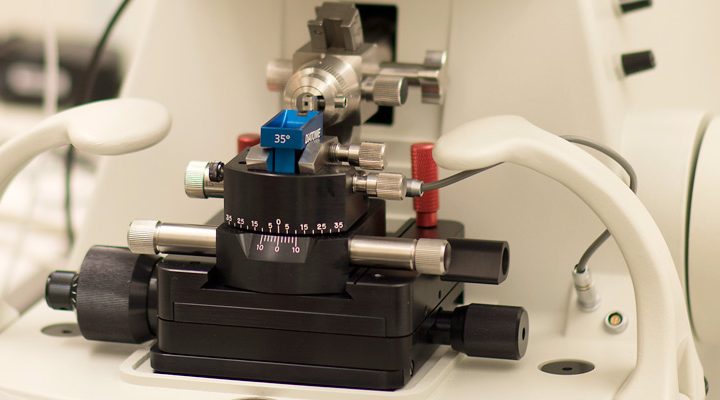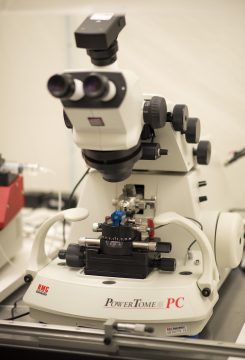
 NEW EQUIPMENT. Malignant melanoma, winter vomiting disease and nephritis are some research areas that can derive great benefits from the new high-tech equipment now available in Sweden and Gothenburg, thanks to a grant from IngaBritt and Arne Lundberg’s Research Foundation. With correlative light-electron microscopy, researchers can now acquire better research data in less time.
NEW EQUIPMENT. Malignant melanoma, winter vomiting disease and nephritis are some research areas that can derive great benefits from the new high-tech equipment now available in Sweden and Gothenburg, thanks to a grant from IngaBritt and Arne Lundberg’s Research Foundation. With correlative light-electron microscopy, researchers can now acquire better research data in less time.
It is like seeing the Manhattan skyline in the night full of light, and then during the day being able to determine which of the buildings gave off light. That is how Göran Larson, a professor in the Department of Laboratory Medicine at Sahlgrenska Academy, describes correlative light-electron microscopy.
Though, of course, researchers are looking not at Manhattan but at biological material. This requires a scanning electron microscope, a super-resolving fluorescence microscope and associated advanced software. Combined with what is known as Serial Section Array Tomography, three-dimensional images can also be generated. Thanks to a grant from the Lundberg Foundation, the Center for Cellular Imaging (CCI) at Sahlgrenska Academy is the first in Sweden to be able to offer this technology to researchers in medicine and the natural sciences.
The new equipment at CCI makes it possible to run correlative light-electron microscopy in 2D and 3D, using both the new equipment and other upgraded light microscopes. The equipment already available at CCI enables the study of structures ranging in size from nanometers to millimeters. In other words, from miniscule particles, viruses and cell components to whole cells and tissues. CCI has several traditional light microscopes and a high resolution fluorescence microscope, which, with some tinkering, transcend the limitations imposed by the length of light waves. The center also has the expertise and equipment for preparing material for various electron microscopy techniques.
Seeing the background in the electron microscope
Correlative light-electron microscopy involves first marking a particular protein in a tissue to be studied with fluorescence. In a light microscope you can see if the protein in question is in the preparation; it appears as bright dots. By managing to find exactly the same image with exactly the same magnification in the scanning electron microscope, you can see the background in the form of cell structures and particles, which then provides a much better idea of where the marked protein is located and whether it interacts with certain cell components.
Several thousand slices automatically
The new equipment also includes an automated ultramicrotome, a device that uses a diamond knife to slice preparations into nanometer-thin cross-sections, which are attached and embedded in plastic. The slicing has been completely automated and can continue for hours and days. The result can be several thousand cross-sections. When these are then analyzed in the new scanning electron microscope, the software assembles all the images into a three-dimensional image that can be correlated with the corresponding image from the light microscope.

“The fact that the slicing occurs automatically means huge labor savings. At the same time these new technologies generate such an incredible number of images that the reading must be automated,” says Göran Larson, who until the summer of 2018 was director of Core Facilities at Sahlgrenska Academy, which includes CCI.
Julia Fernandez-Rodriguez, a researcher and manager for CCI, says that there are more advantages with the new equipment. For example, all fixed material remains so that you can go back and look at it again or explore a different part of the tissue that you might not have thought was very important at first.

“Previously, researchers had to try to locate the area of interest manually using light microscopy and then ask the staff who handled the electron microscope to slice their way to the correct area in the preparation. The material cut away was then lost. With the new automated slicing, all of the cross-sections are saved on a band and everything remains.
Many will benefit from the new equipment
Obviously, many researchers see opportunities with CCI’s new equipment. Max Levin, an assistant professor at the Department of Oncology, will study how blood vessels form when malignant melanoma metastasizes. Jenny Nyström, a professor in the Institute of Neuroscience and Physiology, wants to study a receptor protein that her research team believes may be associated with the development of IgA nephropathy. It is the most common inflammatory renal disease, and there is still no cure for it. Göran Larson himself hopes to learn how cells absorb the calicivirus, which causes winter vomiting disease. In this way he hopes to get one step closer to a vaccine for the disease. Just to name a few projects.
CCI is a resource for many researchers
CCI is part of the Sahlgrenska Academy’s Core Facilities, a university-wide analysis and development department. Researchers go there with their questions and receive help with analyses that often are so advanced they require specially trained staff to operate the equipment. As part of the national research infrastructure for microscopy, CCI is available for researchers from the rest of Sweden as well. Göran Larson and Julia Fernandez-Rodriguez say that the grant from the Lundberg Foundation, like earlier grants to Core Facilities, has been invaluable in purchasing such advanced equipment as that now available at CCI.
The new equipment for correlative light-electron microscopy at Medicinareberget is available for researchers in medicine and the natural sciences throughout Sweden. The range of relevant projects is extensive, just within Sahlgrenska Academy. For example, various researchers here will study blood vessel formation in the spread of malignant melanoma and examine a protein that may play a role in developing the most common form of kidney inflammation, for which there currently is no cure. Göran Larson is among those who are furthering their research with the help of the new equipment. “Now we can obtain more knowledge about how cells absorb the virus that causes winter vomiting disease. I hope it takes us a step closer to a vaccine,” he says.
TEXT: ANNIKA SÖDERPALM / BIRGITTA PLYHM
PHOTO: ANNIKA SÖDERPALM










